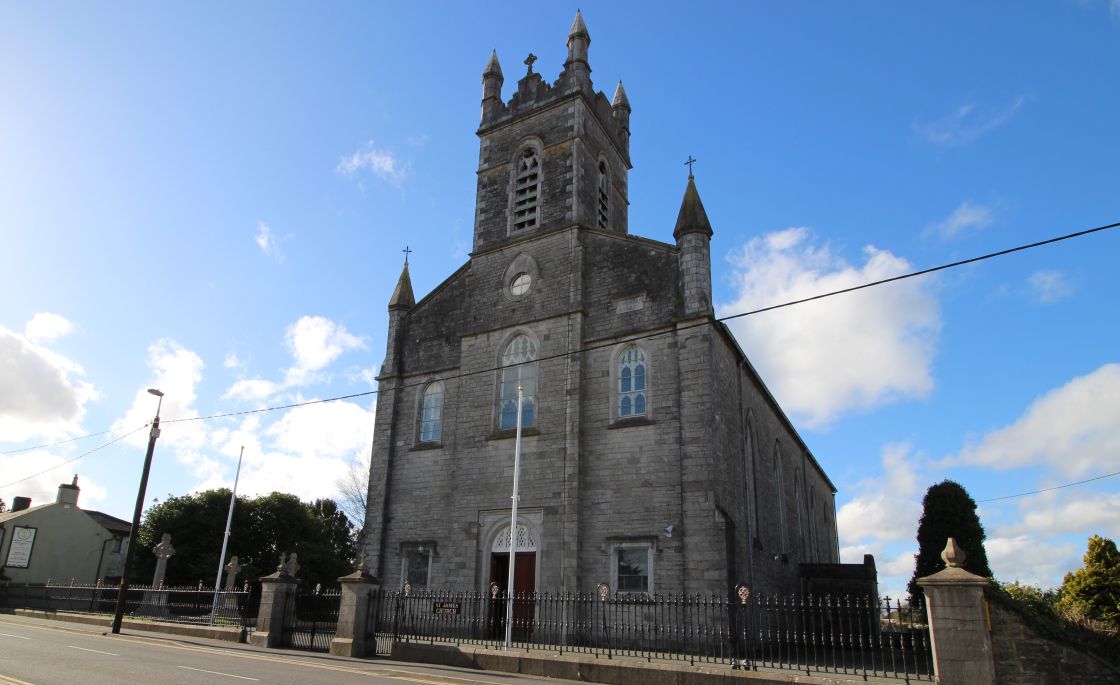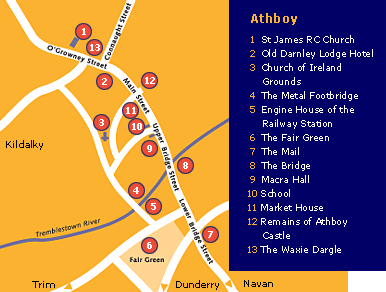1. St James R.C.
Church Completed in 1845 at the time of the great famine, the building was constructed under the direction of Rev. Fr. Rickard, P.P., whose remains are interred in the church. Within the grounds stands a statue of Fr. Eugene O¹Growney, one of the founders of the Gaelic League. He had a major influence in arresting the decline of the Irish language. The statue was executed by Seamus de Paor and was unveiled by the then President of Ireland, Sean O¹Kelly, in 1956.
2. The Old Darnley Lodge Hotel
This was the estate office for the Darnley Family who owned the town of Athboy and surrounding land from 1770. The family had an enormous influence on the develop-ment of Athboy until the power of the landlords was finally weakened by the Wyndham Act of 1903. They eventually sold the town in 1909.
3. The Church of Ireland Grounds
The church was erected in 1772. The tower, from a previous church built by the Carmelites, was incorporated into the building and still stands. The house which was the residence of the church sexton is now the town library. Part of the old wall of Athboy can be seen at the end of the cemetery this was built by the Normans in the 11th century to protect the settlement.
4. The Metal Footbridge
This footbridge crosses the Yellow Ford the river from which Athboy derives its name. It was at this point that the original street of Athboy crossed the river leading to the Fair Green and the Hill of Ward (Tlachtga), an ancient Druidic settlement.
5. The Engine House of the Railway Station
These fine stone buildings were part of the railway line which served Athboy for nearly one hundred years. Opened in 1864, the line ran from Athboy to Dublin. It was officially closed in 1957. The Midland and Great Western locomotives were particularly known for their very distinctive livery they were painted emerald green with vermillion coloured nameplates. The station suffered severe damage from a bomb blast during the Civil War in 1923.
6. The Fair Green
This is probably the oldest habitation site in Athboy. Situated close to the Druidic settlement of Tlachgta (the Hill of Ward), it is here that the inhabitants held their sports and contests. The green was donated to the people of Athboy by Lord Darnley in 1909. It was used as a site for the monthly cattle fairs until these were discontinued in 1955. The green was developed as a public park in 1999.
7. The Mall
It was here that soup was distributed to victims of the famine. The soup was prepared in a huge pot which could be wheeled over the fire. To the rear of the Mall are the Athboy lodge stables and yard. These were owned by the Dyas family who also owned Mannifesto, the first horse to win the Aintree Grand National twice.
8. The Bridge
It was the erection of this bridge around 1400 which created the present line of the town. The river beneath the bridge was diverted to accommodate the operation of the water wheel for the nearby cornmill.
9. The Macra Hall
Formerly the courthouse, Macra Hall was built in 1863 as part of a complex occupied by the R.I.C. (Royal Irish Constabulary). This comprised of a barracks (now the Bank of Ireland) and a jail. Meath County Council purchased the building and used it as a courthouse until it was sold again in 1964. The Hall was then thoroughly renovated and has since become a centre of youth activity in the area.
10. Athboy School
This fine stone building dating from 1885 was the primary school in the area until it was closed in 1949. It was then purchased by the Mercy Order who operated a secondary school there for another 13 years.
11. The Market House -Mc Elhinneys Bridal Boutique
This was formerly the market house where farm produce was bought and sold for many years. The weekly market was held on Thursdays and had an official weigher for the weighing of grain, potatoes and vegetables. In season, wool would have also been bought and sold here.
12. The Remains of Athboy Castle
Beneath this house lie the ruins of Athboy Castle. The castle, built in 1180 by the Normans, guarded the approach to the town from the west. The lane to the side of the house is the original street of Athboy which ran at right angles to present-day Main Street.
13. The Waxies Dargle
This was once an inn known as TheLudwidge Arms. It was a coaching inn with stable accommodations where horses were changed on the Dublin/Connaught run which ran via Killeshandra. Descendants of the Ludwidge family still live in the locality.
Download the Athboy Heritage Trail below

